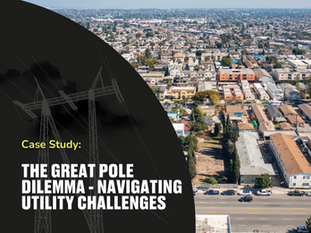
LADWP Staging Area Requirements in 2025: What Developers Must Know
May 2
3 min read
2
70
0

As Los Angeles continues to densify and modernize, utility planning has become a pivotal—and often underestimated—component of real estate development. Among the most critical considerations is compliance with the Los Angeles Department of Water and Power’s (LADWP) updated transformer staging area requirements.
Failing to plan for these staging areas early in the design phase can lead to costly delays, unexpected redesigns, or even project termination. Here’s what you need to know in 2025 to keep your project on track.
What’s Changed in LADWP’s Staging Requirements?
In past years, LADWP often permitted transformer staging areas within the public right-of-way (ROW). However, that’s no longer the norm.
Due to enhanced safety protocols and the increasing size and complexity of LADWP’s utility vehicles and equipment, the utility now strongly prefers that staging areas be located on private property—and meet more stringent specifications.
One major reason for this shift: LADWP’s fleet now includes larger utility trucks to accommodate the growing demand for electricity, especially from mixed-use and high-density developments. These new vehicles require bigger turning radii and more space to safely deploy equipment.

How Large Are Staging Areas in 2025?
Today’s staging area requirements reflect LADWP’s upgraded infrastructure standards:
Smallest Transformer Configuration:
Minimum of 22 ft x 42 ft
34.5kV Systems (Dual Structure Projects):
36 ft x 50 ft or 36 ft x 56 ft
These expanded footprints demand substantial real estate and come with critical design restrictions.
LADWP Staging Area Design Guidelines: Key Compliance Factors
To receive LADWP approval, staging areas must adhere to the following design requirements:
Be free of obstructions: no trees, benches, light poles, signage, or street furniture
Be open to the sky: no canopies, overhangs, or overhead wires
Be ideally located on private property
Maintain clearance from overhead utility lines and poles
The final point is where many urban developments encounter issues. Existing overhead infrastructure—especially common in infill projects—can prevent LADWP from approving a staging area. In such cases, LADWP may mandate the undergrounding of power lines, which is a complex and costly process.
The Cost of Noncompliance: Delays, Budget Overruns, and Lost Revenue
Developers who overlook LADWP staging requirements may face major setbacks:
Undergrounding lines can take 2–3 years, depending on LADWP’s design queue, telecom coordination, and construction complexity.
Costs for undergrounding can run into hundreds of thousands or even millions of dollars.
Lost rentable square footage from staging areas on private property may lead to reduced ROI.
Failing to budget for these expenses can jeopardize the entire project.
Can You Still Use the Public Right-of-Way?
Sometimes—but only under strict conditions.
LADWP may consider public ROW staging only if:
No viable private property option exists
Safety and clearance standards are fully met
Multiple agencies approve during an extended review process
This is not a shortcut—it’s a last resort.
Don’t Wait—Get Ahead with CREDE
At CREDE, our Dry Utilities Team specializes in navigating LADWP’s evolving requirements. We work closely with developers from preliminary planning to final LADWP sign-off, helping projects stay compliant and cost-effective.
Our Services Include:
LADWP-aligned preliminary staging area reviews
Conflict analysis for overhead utilities
Site layout design recommendations
Support through the LADWP review and approval process
With our team’s guidance, developers can proactively resolve staging issues—avoiding budget blowouts and preserving timelines.
Ready to Future-Proof Your Project?
Don’t let a transformer staging oversight derail your plans. If you're developing in LADWP territory, it’s time for a strategic review.
Contact
Chris Rad
Director of Dry Utilities
(714) 900-5500


